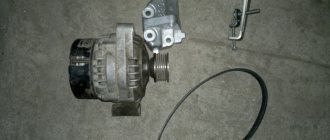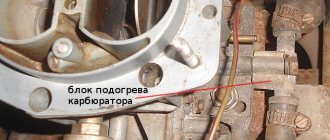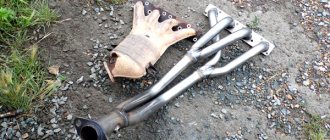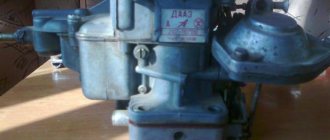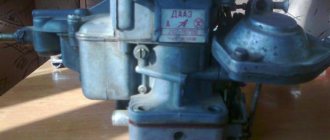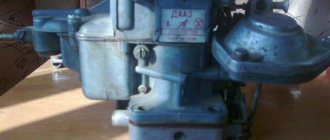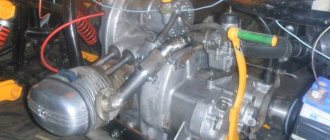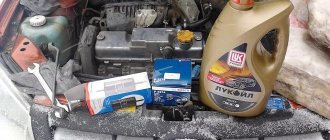Many owners of Lada cars are thinking about how to install forward flow on a VAZ 2114. This may be caused either by a desire to increase power or by a desire to give the car a more individual, sporty look. Be that as it may, doing it yourself is quite simple. We will tell you exactly how in today’s article.
Direct flow vaz 2114
Which muffler should I put on the VAZ 2114?
Which muffler should I put on the VAZ 2114?
Are you tired of repairing or changing the muffler on your car, and are asking yourself the question which muffler is better for the VAZ 2114?
In this article we will try to find out how to choose a muffler for a VAZ 2114, and which muffler is better to put on a VAZ 2114? First, let's find out what the exhaust system of the VAZ 2114 consists of, and why does the muffler have to be changed so often? The exhaust system of this VAZ model consists of (the list does not include gaskets and fasteners):
- intake pipe;
- catalytic converter (catalyst);
- oxygen sensor;
- additional muffler (resonator);
- exhaust system connecting pipes;
- main muffler;
- exhaust pipe.
The thinnest metal is used in the resonator and muffler, since they bear the least vibration and temperature loads, especially on the muffler. However, thin-walled exhaust elements are most susceptible to corrosion and exposure to salt in the winter, which leads to the rapid need to replace them. The muffler was developed at the factory as a consumable item rather than as a part designed for long-term use. But the need to replace it after half a year is very unpleasant financially and labor-intensive, hence the question arises, which muffler would be best to install on the VAZ 2114?
Muffler VAZ 2114, which one to choose?
All standard factory or factory made stock mufflers are not designed to last long, up to 3 years to be exact.
And this is a rather optimistic figure. However, different muffler options from different manufacturers will vary in quality. And this will also determine how much the exhaust system for a VAZ 2114 costs. And so what quality mufflers are there, and how much does a muffler for a VAZ 2114 cost in this regard:
- the cheapest option is thin-walled mufflers of dubious manufacture, as a rule, they are very light in weight and have a service life of six months;
- budget options - standard steel thickness (about 1.2-1.5 mm of the walls of the muffler can), service life up to 2 years;
- budget options with anti-corrosion coating - standard stock mufflers made of aluminized or galvanized steel, service life 2-3 years, with constant use of the car;
- above the standard price - mufflers made using stainless steel or corrosion-resistant steel, service life up to 5 years;
- expensive branded mufflers made entirely of stainless steel, service life more than 5 years.
An important criterion is how much a VAZ 2114 muffler costs. If you want to avoid having to buy and replace a muffler for a long time, then there is no point in saving. If you read reviews about the different types of silencers presented on our market, you can understand which silencer is better for the VAZ-2114.
And one more thing, often car owners try to install a muffler from another car, for example, install a VAZ 2105 muffler on a VAZ 2114, or from an Audi, Saab, etc. This is not recommended.
- firstly, you will disturb the exhaust configured at the factory;
- secondly, you will have to redo the exhaust mounting system, which often has a negative impact on the lower part of the body.
But if you decide to redo it, then you can try installing a direct-flow quiet exhaust.
Which forward flow should I put on the VAZ 2114?
It’s worth mentioning right away that it is better to install a high-quality direct-flow exhaust system with an original sound that does not exceed the noise standards established in our country.
This, of course, will depend on how much direct flow on a VAZ 2114 costs, but in this case you shouldn’t go too cheap. Straight-through (sports) mufflers are conventionally divided into two categories:
- direct flows designed for installation in a standard place and under the factory mounting system, without the need to modify the rear bumper;
- direct flows that require modification of the exhaust system, fastening system and/or rear bumper of the car.
How to install forward flow on a VAZ 2114 will depend on which muffler model you choose.
High-quality straight-through stainless steel mufflers will serve you for many years, although they are expensive. More budget models are designed to last from 3 to 5 years, but this is also quite a long time, judging by the general service life of mufflers on our market.
Resonators for VAZ 2113, 2114, 2115 — Select
Tuning the exhaust system of VAZ 2114
Those who planned to modify the exhaust system in order to increase power were deeply mistaken. Since even the simplest calculations show that the increase in power due to forward flow or any other modernization is completely imperceptible even on a special stand, and even more so in the conditions of real vehicle operation. Sports direct-flow engines could make beautiful and impressive noise and frighten young children with menacing pipes of huge diameter, but this has nothing to do with the technical tuning of the car.
Another thing is preparing a new exhaust system to increase service life and reliability. In this case, completely different circuits, completely different pipe materials and completely different resonator designs were used. The undoubted advantage of this modification was the use of stainless steel, which could outlive the car itself. Also, the reliability of the system was affected by the corrugation, which was also often replaced with a more reliable one from third-party manufacturers.
In general, you don’t have to want much from the exhaust system of the VAZ 2114; you just have to monitor its condition, check the rubber suspensions from time to time and periodically replace the mufflers and exhaust pipes with new ones. Don't drive the exhaust pipes into holes, and good luck to everyone!
Diagram for 1.6 l engines
The exhaust system of cars equipped with 1.6 liter engines is distinguished by the fact that it does not contain a neutralizer; this element is replaced by a metal “corrugation”. The exhaust system of the 1.6-liter VAZ 2114 is also equipped with a catalytic manifold, which is mounted after the sealing gasket (3). Let's add a few words about the fastening of the entire structure - it is suspended from the bottom of the car on five suspension cushions, and its component parts are connected to each other using gaskets, O-rings and clamps. And some more information for your information - the exhaust system of VAZ 2115, 14, and 13 has a toxicity standard of R 83.
We install direct flow
What will installing direct flow on these VAZ models give us? First of all, a powerful sound that will inevitably attract attention. Plus - beautiful appearance. But that's not all - such a modification can lead to an increase in engine power by 6 percent. True, to achieve this, comprehensive measures are needed. A standard direct-flow muffler is made from a pipe with a diameter of 50 mm.
Of course, it can be made from a larger diameter pipe - for example, 60 mm, but there will be no practical benefit from this. In order for a direct-flow exhaust system to be manufactured with high quality, the services of a specialist who is well versed in this are needed. In addition, such a system needs to be installed only after the engine has been well “pumped”. In other words, if we simply change the banks of the exhaust system by installing others, this will not add power to the power unit. Therefore, before installing a forward flow, think about whether you really need it.
After installing the system, the car will have a peculiar “sound” - many car owners are attracted to it - they believe that this way the car “looks” much more solid. One problem is that the traffic police may punish you for this sound. But if this doesn’t stop you, let’s first get to know what forward flow is. This is nothing more than a completely redesigned exhaust system.
The forward flow includes three components - a collector, which is specially tuned, a resonator and, directly, the muffler itself. The entire system is made of aluminum or stainless steel. Therefore, at the beginning you need to purchase two pipes: one of them should be equal in diameter to the diameter of the standard muffler of your car. The second pipe should be approximately 1 m long and 200 mm in diameter. We will also need a stock muffler, and preferably it will be new.
Work order. First, we disassemble the old muffler and remove everything that is inside it. Taking a pipe equal in diameter to a standard muffler, we make holes in it. After that, we weld another one to this pipe. A small recommendation: when welding, use a small metal plate, which will add additional rigidity. After the pipes have been welded, we install the entire structure back into the muffler, and we also weld this system. Do not forget that while the engine is running, the forward flow will quickly heat up, so it must be thermally insulated. To do this, you need to put a kind of cylinder made of heat-protective foam on the body. In addition, the entire system must be protected from adverse operating conditions under the vehicle. To do this, the direct flow can be covered with a separate stainless steel sheet so that it can then be rolled. The next step is to make a special eye, with the help of which the forward flow will be attached to the bottom of the car.
Among the disadvantages of such a system is a loud sound, which often annoys others, and increased fuel consumption. To achieve low bass, it is not at all necessary to install a straight pipe; it is enough to increase the diameter of the pipe leaving the exhaust system. As a rule, on sports cars the standard mufflers are replaced with a “spider” system, which differs significantly in its shape and connection order from standard exhaust systems. The video shows the sound produced by the Stinger forward flow installed on a VAZ 2114.
Results of installing a direct-flow muffler
By converting the muffler to direct flow, you will receive the following advantages:
- increase in power (on average - by 5-10 hp);
- more aggressive exhaust sound (especially at high speeds);
- a slight increase in maximum speed.
At the same time, it is worth understanding that for the most part, installing direct flow gives the car individuality, but does not make colossal changes to its characteristics. It will not be possible to achieve a sharp increase in the maximum possible speed or acceleration to hundreds in 10 seconds by simply modifying the muffler.
A little theory
Muffler operation diagram
Tuning the exhaust system is one of the main components of the sporty modification of VAZ cars. With a standard exhaust system, the engine does not realize its full potential. It's a matter of exhaust design. The internal part of the muffler is made in the form of several tubes that disperse the flow of exhaust gases.
Some of the power is lost at the muffler "bank". Converting the muffler to direct flow allows you to slightly reduce losses.
The best result is obtained in combination with other measures: removal of the catalyst and chip tuning, which optimizes the operation of the lambda probe for the new exhaust system. Making changes to the exhaust design changes the amount of oxygen in the exhaust gases. With standard computer settings, injection will not work correctly.
Results of installing a direct-flow muffler
By converting the muffler to direct flow, you will receive the following advantages:
- increase in power (on average - by 5-10 hp);
- more aggressive exhaust sound (especially at high speeds);
- a slight increase in maximum speed.
At the same time, it is worth understanding that for the most part, installing direct flow gives the car individuality, but does not make colossal changes to its characteristics. It will not be possible to achieve a sharp increase in the maximum possible speed or acceleration to hundreds in 10 seconds by simply modifying the muffler.
Symptoms of a problem
The car itself will tell you when the muffler needs to be replaced. You just need to listen for the characteristic signs of its malfunction:
- Noise increases when the engine is running;
- There is an exhaust smell inside the cabin or near the car;
- Exhaust gas smoke comes out from under the bottom due to the formation of a hole in the exhaust system.
Tuning the gas exhaust system
The exhaust system of the VAZ 2114 also allows you to increase the power of the vehicle's power unit thanks to the installation of forward flow. The engine is boosted by accelerating the exhaust gases.
The principle of operation of direct-flow systems involves the creation of a rarefied atmosphere in which flows flow faster from the combustion chamber into the fuel cylinders. Increasing speed proportionally increases power, creating the necessary resistance.
Its value reaches about 10% above what is initially included in the technical characteristics of the exhaust unit without a direct-flow unit.
In a standard muffler, the resistance rate is much higher - 60-70%, which significantly slows down the release of exhaust gases. Equipping with such a unit also increases engine power by 6%. It is important to note that this happens without any structural changes to the gas exhaust system, which often require substantial investment.
Assembling a direct flow in the body of an old muffler
If for one reason or another you are not satisfied with the option of purchasing a ready-made direct-flow muffler, there are two options for creating it yourself:
- assembly in the body of an old muffler;
- construction of a new part.
The first option is simpler and cheaper. To carry it out, relatively straight arms and a welding inverter are enough. The advantage of this method is the minimal impact on the computer settings for the oxygen sensor and a slight (if assembled correctly) change in engine noise. The sound will become more bassy at revs, no more.
Ready homemade forward flow
- Remove the old muffler and cut out a full-length window in the body.
- Remove contents and outlet pipe.
- Make and weld into the muffler a “flute” from a perforated pipe or an ordinary pipe, in which cuts are made with a grinder or holes are drilled with a drill. This design disperses the flow of gases, reduces noise and exhaust temperature.
- Weld the exhaust pipe. For aesthetics, you can use a single or double chrome pipe. Perforate the part that is inside the muffler with a drill.
- It is advisable to fill the muffler with mineral wool. You can also use asbestos sheet, glass wool or other heat-resistant material.
- Weld the window in the housing.
To minimize the carryover of filler through the holes in the perforated pipe, it can be pre-wrapped with a metal mesh.
Assembling a new direct-flow muffler
This method is preferable for lovers of an exciting sports exhaust sound. It is advisable to cut off the bent part of the inlet pipe from the old muffler and weld it to the new one. Bending a new one in this way is a labor-intensive and time-consuming process.
Rest of the process:
- Weld flanges to the perforated pipe on both sides.
- Wrap the pipe with steel mesh or heat-resistant fabric.
- Select a steel pipe with a diameter approximately equal to the flanges, put it on the structure, while simultaneously filling the internal space with mineral wool or a material with similar properties.
- Weld the joints of the pipe with the flanges.
Creating a new direct flow with your own hands has a significant disadvantage. It is impossible for a non-professional to make an aesthetic structure from chrome-plated pipes: it requires skills and special welding equipment (at least a semi-automatic machine, preferably an argon welding machine). In addition, fastenings must be provided for the new muffler - and this is additional work.
Another problem is the choice of pipe for the new housing. Thin-walled ferrous metal can quickly burn out, and a thick-walled pipe (4-5 mm) greatly burdens the structure. Standard rubber hangers won't last long. The optimal choice is the golden mean.
If you decide to make a direct-flow muffler with your own hands, it is better to settle on assembling it in an old housing. It's faster, more practical and requires less skill and equipment.
What to expect from a straight-through muffler:
- slight increase in engine power (with significant modification of the exhaust system)
- improved exhaust sound at rpm.
And what not to do:
- acceleration 0-100 in 8-9 seconds.
Tuning the exhaust system of a VAZ 2114 only frees 5-6 horses “stayed in the stalls”. It affects acceleration and, especially, the maximum speed of the car insignificantly.
Official recommendations
Naturally, the manufacturer recommends installing silencers made by AvtoVAZAgregat of the appropriate modification. The recommendations are justified by the following arguments:
- Compared to competitive products, jammers weigh more. According to factory workers, this means that their walls are thicker and will last longer (3-5 times, according to the manufacturer).
- The insides of the muffler are filled with special cotton wool, which collects condensation and prevents it from causing corrosion.
Where to glue
Before you start work, be sure to familiarize yourself with the purpose of this or that material that will be involved in the soundproofing procedure of your car.
- Vibroplast will serve to cover exposed metal. The main function of a vibroplast is vibration damping.
- Izolon also has properties to dampen vibrations, but it is less effective compared to vibroplast. The structure of the material with closed cells will serve excellently as a second layer after vibroplast.
- Foam rubber is another layer that can be glued after vibroplast and isolon. The last layer will effectively absorb noise.
Dashboard noise
There was foam rubber, now there is bitoplast
It is quite possible to make bitoplast from foam rubber with your own hands. There is nothing complicated in this procedure.
- Protective gloves;
- White Spirit;
- Rubber bitumen mastic.
So, let's get to work.
- Dilute the mastic with white spirit to obtain the consistency of liquid sour cream.
- Carefully treat the foam rubber with the resulting mixture.
- Let the material dry for some time.
- Use homemade bitoplast to soundproof your car.
The material should be dried in the open air, away from people. This is due to the fact that dangerous fumes are released during the drying process.
Replacing a return flow muffler with a direct flow one with your own hands
When manufacturing a direct flow, it is advisable to use the positive properties of several types of structures.
Reasons for replacing a standard muffler with a direct-flow muffler
Car owners change the factory muffler to a direct flow one for several reasons:
- obtaining an increase in engine power;
- subjective improvement of acoustic parameters of the exhaust;
- increasing the aesthetic parameters of the car;
- complete modernization of the exhaust channel;
- The installed muffler has failed.
Tools and materials for work
A direct-flow muffler is often purchased, but for lovers of tools and an insatiable thirst for creativity, we recommend making it yourself. It is preferable to make parts from stainless steel with a thickness of 0.8–2.0 mm. Select ferrous metal blanks with a thickness of 1.0–1.5 mm for the case, the rest 2.0–4.0 mm to avoid premature burnout of parts, and also use standard blanks. For the body, use a suitable size: a fire extinguisher, a thermos, an empty gas or scuba cylinder.
To fill the muffler chamber, non-flammable porous material or a combination of them is used:
- basalt or other mineral wool;
- fine mesh metal mesh;
- metal mesh for the kitchen;
- metal shavings.
- angle grinder (grinder);
- drill or drilling machine;
- welding machine;
- consumables: metal discs for grinders, drills, electrodes, etc.
Reworking an old muffler
- We dismantle the old muffler, disassemble it using a grinder, leaving the body parts and the inlet pipe. While preserving the partitions, we drill holes in them for the passage of exhaust gases. The cameras further reduce exhaust volume.
- We perforate the inner pipe in an accessible way. The diameter of the perforated pipe is equal to the diameter of the inlet pipe or more up to 30%.
Keep in mind that mineral wool fibers will be “blown out” of the chamber faster through large holes and grooves.
In the future, the diameter of the inner pipe can be reduced by simple manipulations, but increasing it is disproportionately more difficult.
- We put metal mesh for the kitchen in place of the perforation of the pipe.
- Wrap the kitchen mesh tightly with metal mesh in 1-3 layers. We fix the mesh with annealed steel wire with multiple twists or crimp it with several clamps.
- We coordinate and clean the welding points, weld the perforated pipe into its regular place.
- We fill all free space inside the muffler tightly with the selected filler.
Working with mineral wool requires personal protective equipment.
- We grab the edge of the “lid” of the body with two or three tacks to avoid displacement and weld the body.
- To protect against corrosion and give it an aesthetic appearance, we paint it with heat-resistant paint in your favorite color.
- We install it on the car. We start the engine. We rejoice!
- To make the muffler last longer, we drill one or more holes with a diameter of 1.5–2.0 mm in the housing to drain condensate. To determine the lowest point, the car must be horizontal.
ABOUT SIGNS OF PROBLEM
As soon as there is even the slightest suspicion of problems with the exhaust tract, it is necessary to take measures to identify and eliminate these suspicions. Driving with a faulty muffler can cause problems from neighbors and traffic police.
You should be alert to the following manifestations in the operation of the exhaust system:
- The appearance of increased noise from a running motor;
- The presence of exhaust odors near the car, and in some cases in the cabin;
- The appearance of smoke from burnt-out exhaust elements under the bottom of the car;
There is no need to put off solving this problem. Take a few minutes to locate and determine the breakdown. After this, a decision is made to eliminate it. There can be only two options here: repairing the muffler or replacing the VAZ 2114 muffler.
How to do it yourself?
If you have enough time and materials, you can approach making the product yourself. But even in this situation, you will have to purchase the main parts of the exhaust system.
There are two creation options that experienced drivers know about:
- The first option is to create an exhaust with different angles. So you just need to weld one pipe from the side into the pipe that runs from the manifold. At high speeds, exhaust gases will exit the pipes unevenly.
- The second solution ensures the same amount of exhaust gases from both pipes. Two products are connected to the pipe that comes from the collector by welding, only the angles will be the same. This product looks more attractive.
Feel free to choose the option that is most attractive to you and convenient for you in terms of production.
How to repair a “glushak” with your own hands
The muffler on the “fourteenth” and “fifteenth” is considered one of the most vulnerable points of the car. The fact is that due to exposure to high temperatures, the metal quickly burns out, that is, the tightness of the system is broken. Therefore, the part must be changed as soon as there is a suspicion that it is not working.
Reasons for failure
Most often, mufflers “burn out” - that is, due to hot exhaust, the metal inside the housing begins to thin out, which ultimately leads to the appearance of holes. However, this is not the only reason why the silencer may fail:
What is the danger of water in the muffler?
Natural transparent condensation is not a problem if there is little of it. It’s just water - its accumulation, on the contrary, indicates the serviceability of all systems. Things get worse if the moisture has an unusual color and thick black smoke appears.
Danger No. 1 - condensation can turn into ice. This threatens to rupture the muffler or resonator. In addition, when water freezes, important channels connecting the motor to other systems become clogged. Therefore, it is very difficult, almost impossible to start the car.
Danger #2 is corrosion. The internal cavities of the exhaust system quickly rust. For example, on the first VAZ cars, the resonators and pants rotted in almost 3 years, although they were made of durable steel. With a stainless muffler of foreign cars, things are somewhat better, but condensate can react with sulfur dioxide (present in the exhaust of any internal combustion engine), form acid and corrode the metal in 1-2 years.


